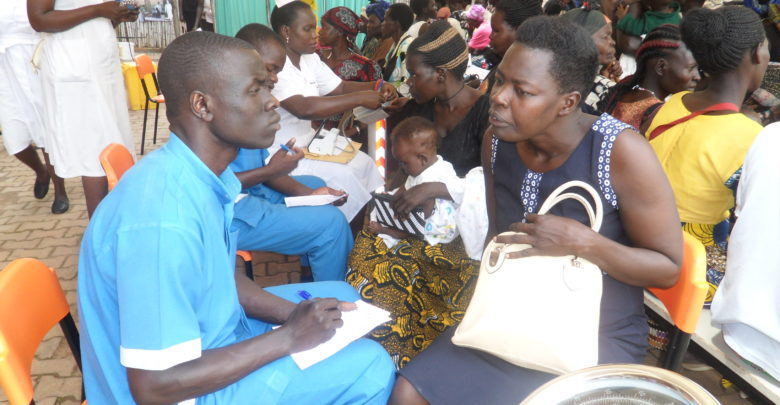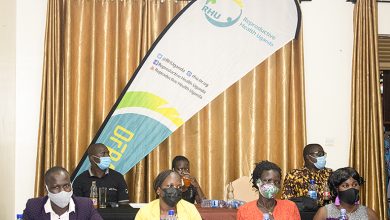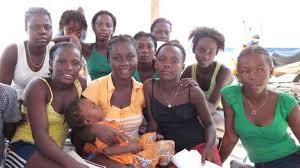
Health
UGANDA:THE AGONY OF MALARIA ON HEALTH AND ECONOMY OF WOMEN IN GULU
“We are overwhelmed as department to attend to our patients and that is the biggest challenge we have in Maternity yet it’s very sensitive to work in” Sister Jennifer Amono, the In-charge Maternity Ward at Gulu Regional Referral Hospital.
Malaria has continued to be among the leading causes of death in Northern Uganda and it is reported to have claimed the lives of 66 people in Gulu with more than 142,827 others who suffered from the epidemic according to report from Gulu district health department of 2019.
The 9 months’ report was captured on the District health information system between January 2019 to the second week of September 2019 of monthly report on malaria under the Ministry of health.
The highest incidents of deaths and infections were recorded between June and July accounting for 42 cases of the total deaths with more than 53525 cases of the overall infections in the district.
At Gulu Regional Referral Hospital, Sarah Akech, a 25 year old pregnant mother from Customs Corner in Gulu is one of the many patients battling with complications of severer malaria in the District.
In her 7 months of pregnancy, Akech has been hospitalized with malaria at Maternity Ward for 5 times whose treatment has cost her more than UGX 200,000 as she explained.
“I haven’t been getting drugs here at Gulu Regional Referral Hospital for more than three times and the nurses would tell us to buy them from pharmacies yet I couldn’t afford” the 25 year old pregnant mother Akech explains.
The average cost of treatment for each time she fell sick of malaria was UGX 45,000, the extra economic burden of the family she has incurred in the year.
On Monday 7th October 2019 again, Akech was rushed to Gulu Regional Referral Hospital in comma confirmed with malaria and admitted at Maternity Ward.
However, the drug stock out has continued to persist in the health facility following the overwhelming number of patients and she was as usual advised to buy drugs from outside the hospital.
However, the family she lives in is surrounded with many trenches, the breeding places for mosquitoes and that could explain why Akech has frequently fallen pray for malaria as she remembered.
Laiaka Betty Alal and the family, a 44 year old resident of Kacubi Parish in Gulu Municipality has equally never lived free of malaria not even a single month in 2019.
Few hours later after she reported to Gulu Regional Referral Hospital on Monday with malaria, her 8 year old daughter then followed her in the same facility confirmed with the same infection.
Laiaka, a vegetable grower and a business woman in Gulu has spent more than UGX 300,000 on treatment alone in 2019.
The expensive cost of treatment she incurred was from the private health facilities until she decided to go to government hospital only to find the health facility in persistence of drug shortages.
She however appealed to government to build more capacity of the village health workers and assign them with some of the essential drugs to administer in the villages.
“We are overwhelmed as department to attend to our patients and that is the biggest challenge we have in Maternity yet it’s very sensitive to work in” Sister Jennifer Amono, the Incharge Maternity Ward at Gulu Regional Referral Hospital.
With dismay, Amono revealed that only 9 of the health workers are operating the unit which she said has made it difficult to provide quality health care and services to the overwhelming number of patients in the facility with only 1 personnel at times deployed to working at night.
She also revealed that malaria is the leading cause of death in premature babies and that they register at least 20 cases per month.
“Most of these mothers already come with severer complications , some come when the babies have died inside and that explains why we couldn’t save many as we continue to register more deaths in such children” Sister Amono.
The unit according to her should have accommodated only 27 inpatients but the number has exceeded more than 40.
“We have run short of beds, many are now sleeping on the floor and we can’t help the situation now that we have malaria as an epidemic in the region” Sister Amono added.
She however blamed the incident on the locals whom she says haven’t embraced simple malaria control and prevention.
Key among what she outlined as best practices for malaria prevention were sleeping under the insecticides treated net, destroying all breeding places for mosquitoes which include bushes and stagnated water.
She however believes that malaria infections can still scale down in the region if communities have embraced such mechanisms and urged the locals to equally undertake test and treatment policy to reduce on malaria related deaths.
According to Loum Bishop Janani, the Incahrge Public Health Department at Gulu Regional Referral Hospital, what is needed most is to strengthen awareness campaign on malaria in the villages where a number of cases are still not reported.
Loum disclosed that the biggest numbers of people in the outpatient department are those presenting with malaria which is reportedly exceeding more than 300 of the daily attendance.
He says the overwhelming cases of malaria in the facility has continued to give ground to stock out of drugs in the facility mostly the new malaria drug (Artesonate).
“The hospital like this shouldn’t handle simple primary care, we should only be handling complications and specialized services, we have the lower health facilities for primary health care” Loum in statement.
He has similarly acknowledged the gap in staffing experienced in the hospital but noted that the situation is being bridged by the medical interns.
However, of the total number of malaria cases recorded in the Gulu, more than 9,200 were either referred or reported to Gulu Regional Referral Hospital according to the record from the hospital.
About malaria
Malaria is a life threatening disease sometimes fatal typically transmitted through a bite of anopheles mosquitoes according to World Health Organization. The infected mosquitoes will carry parasite (Plasmodium) and feed on humans which affects the red blood cells.
It is notable that people who get malaria are typically very sick with high fever, shaking chills and flu-like illness among others but all deaths and illnesses from malaria can be prevented.
Acholi Sub Region and malaria resurgence
The 2018 annual report on malaria by the ministry of health has identified Acholi Sub Region among the hotspot in the Country with high rate of malaria infections.
A total of 677,390 of malaria cases were recorded into the region in 2018 resulting to the death of 1355 people which were more than half of all cases reported in Lango Sub Region with 380,670 cases and death of 590 people respectively.
Though the country has reportedly reduced on malaria cases and deaths in the year 2018 by 52% but Dr. Jimmy Opigo, the Program Manager National Malaria Control Program in his report named Uganda among the top 10 Countries in Sub Sahara Africa which accounts for more than 70 percent of global malaria cases and deaths.
Currently in the 8 Districts of Acholi Sub Region according to Malaria Consortium report of second week of September 2019, Lamwo, Amuru and Gulu continue to present higher cases of malaria infections in the region.
The cases reported in that week from Lamwo were7182, Amuru 4237, Gulu 4041, Nwoya 4096, Kitgum 4061, Pader 2962, Omoro 2436 and Agago at 1274 respectively.
In 2015, Northern Uganda had suffered from series of malaria outbreak shortly after the discontinuation of indoor residual sprays in late 2014.
The current resurgence of the epidemic into the region is suspected to be the result of climate variations notably in the months of June and July and between September and October according to scholars.
A 10 year joined study by Makerere University College of Health Science and Gulu University has placed Uganda third among the top 10 Sub-Sahara Countries with the highest rate of malaria transmissions which were reportedly wider in Northern Uganda.
The related report by the Ministry of health also presents a significant percentage of unreported cases of malaria occurring at home while 27% of inpatient deaths among children under 5 years are due to malaria especially in Northern Uganda which has the highest prevalence of malaria among children at 63%.
The World malaria report of 2018 by World Health Organization has estimated 217 million cases of malaria reported globally in 2017.
The phenomenon is estimated for claiming the lives of more than 435,000 people globally each year largely in Africa.
The infection was estimated to have killed 450,000 people globally in 2017, 451,000 in 2016 and 607,000 in 2010 with 93% of occurred in African Countries.
However, the longer the government takes to equip the health facilities to meet the various health complications in the region, people like Akech and Laiaka will still continue to thrive in poverty on high cost of malaria treatment.
Malaria has continued to be among the leading causes of death in Northern Uganda and it is reported to have claimed the lives of 66 people in Gulu with more than 142,827 others who suffered from the epidemic according to report from Gulu district health department of 2019.
The 9 months’ report was captured on the District health information system between January 2019 to the second week of September 2019 of monthly report on malaria under the Ministry of health.
The highest incidents of deaths and infections were recorded between June and July accounting for 42 cases of the total deaths with more than 53525 cases of the overall infections in the district.
At Gulu Regional Referral Hospital, Sarah Akech, a 25 year old pregnant mother from Customs Corner in Gulu is one of the many patients battling with complications of severer malaria in the District.
In her 7 months of pregnancy, Akech has been hospitalized with malaria at Maternity Ward for 5 times whose treatment has cost her more than UGX 200,000 as she explained.
“I haven’t been getting drugs here at Gulu Regional Referral Hospital for more than three times and the nurses would tell us to buy them from pharmacies yet I couldn’t afford” the 25 year old pregnant mother Akech explains.
The average cost of treatment for each time she fell sick of malaria was UGX 45,000, the extra economic burden of the family she has incurred in the year.
On Monday 7th October 2019 again, Akech was rushed to Gulu Regional Referral Hospital in comma confirmed with malaria and admitted at Maternity Ward.
However, the drug stock out has continued to persist in the health facility following the overwhelming number of patients and she was as usual advised to buy drugs from outside the hospital.
However, the family she lives in is surrounded with many trenches, the breeding places for mosquitoes and that could explain why Akech has frequently fallen pray for malaria as she remembered.
Laiaka Betty Alal and the family, a 44 year old resident of Kacubi Parish in Gulu Municipality has equally never lived free of malaria not even a single month in 2019.
Few hours later after she reported to Gulu Regional Referral Hospital on Monday with malaria, her 8 year old daughter then followed her in the same facility confirmed with the same infection.
Laiaka, a vegetable grower and a business woman in Gulu has spent more than UGX 300,000 on treatment alone in 2019.
The expensive cost of treatment she incurred was from the private health facilities until she decided to go to government hospital only to find the health facility in persistence of drug shortages.
She however appealed to government to build more capacity of the village health workers and assign them with some of the essential drugs to administer in the villages.
“We are overwhelmed as department to attend to our patients and that is the biggest challenge we have in Maternity yet it’s very sensitive to work in” Sister Jennifer Amono, the Incharge Maternity Ward at Gulu Regional Referral Hospital.
With dismay, Amono revealed that only 9 of the health workers are operating the unit which she said has made it difficult to provide quality health care and services to the overwhelming number of patients in the facility with only 1 personnel at times deployed to working at night.
She also revealed that malaria is the leading cause of death in premature babies and that they register at least 20 cases per month.
“Most of these mothers already come with severer complications , some come when the babies have died inside and that explains why we couldn’t save many as we continue to register more deaths in such children” Sister Amono.
The unit according to her should have accommodated only 27 inpatients but the number has exceeded more than 40.
“We have run short of beds, many are now sleeping on the floor and we can’t help the situation now that we have malaria as an epidemic in the region” Sister Amono added.
She however blamed the incident on the locals whom she says haven’t embraced simple malaria control and prevention.
Key among what she outlined as best practices for malaria prevention were sleeping under the insecticides treated net, destroying all breeding places for mosquitoes which include bushes and stagnated water.
She however believes that malaria infections can still scale down in the region if communities have embraced such mechanisms and urged the locals to equally undertake test and treatment policy to reduce on malaria related deaths.
According to Loum Bishop Janani, the Incahrge Public Health Department at Gulu Regional Referral Hospital, what is needed most is to strengthen awareness campaign on malaria in the villages where a number of cases are still not reported.
Loum disclosed that the biggest numbers of people in the outpatient department are those presenting with malaria which is reportedly exceeding more than 300 of the daily attendance.
He says the overwhelming cases of malaria in the facility has continued to give ground to stock out of drugs in the facility mostly the new malaria drug (Atesonate).
“The hospital like this shouldn’t handle simple primary care, we should only be handling complications and specialized services, we have the lower health facilities for primary health care” Loum in statement.
He has similarly acknowledged the gap in staffing experienced in the hospital but noted that the situation is being bridged by the medical interns.
However, of the total number of malaria cases recorded in the Gulu, more than 9,200 were either referred or reported to Gulu Regional Referral Hospital according to the record from the hospital.
About malaria
Malaria is a life threatening disease sometimes fatal typically transmitted through a bite of anopheles mosquitoes according to World Health Organization. The infected mosquitoes will carry parasite (Plasmodium) and feed on humans which affects the red blood cells.
It is notable that people who get malaria are typically very sick with high fever, shaking chills and flu-like illness among others but all deaths and illnesses from malaria can be prevented.
Acholi Sub Region and malaria resurgence
The 2018 annual report on malaria by the ministry of health has identified Acholi Sub Region among the hotspot in the Country with high rate of malaria infections.
A total of 677,390 of malaria cases were recorded into the region in 2018 resulting to the death of 1355 people which were more than half of all cases reported in Lango Sub Region with 380,670 cases and death of 590 people respectively.
Though the country has reportedly reduced on malaria cases and deaths in the year 2018 by 52% but Dr. Jimmy Opigo, the Program Manager National Malaria Control Program in his report named Uganda among the top 10 Countries in Sub Sahara Africa which accounts for more than 70 percent of global malaria cases and deaths.
Currently in the 8 Districts of Acholi Sub Region according to Malaria Consortium report of second week of September 2019, Lamwo, Amuru and Gulu continue to present higher cases of malaria infections in the region.
The cases reported in that week from Lamwo were7182, Amuru 4237, Gulu 4041, Nwoya 4096, Kitgum 4061, Pader 2962, Omoro 2436 and Agago at 1274 respectively.
In 2015, Northern Uganda had suffered from series of malaria outbreak shortly after the discontinuation of indoor residual sprays in late 2014.
The current resurgence of the epidemic into the region is suspected to be the result of climate variations notably in the months of June and July and between September and October according to scholars.
A 10 year joined study by Makerere University College of Health Science and Gulu University has placed Uganda third among the top 10 Sub-Sahara Countries with the highest rate of malaria transmissions which were reportedly wider in Northern Uganda.
The related report by the Ministry of health also presents a significant percentage of unreported cases of malaria occurring at home while 27% of inpatient deaths among children under 5 years are due to malaria especially in Northern Uganda which has the highest prevalence of malaria among children at 63%.
The World malaria report of 2018 by World Health Organization has estimated 217 million cases of malaria reported globally in 2017.
The phenomenon is estimated for claiming the lives of more than 435,000 people globally each year largely in Africa.
The infection was estimated to have killed 450,000 people globally in 2017, 451,000 in 2016 and 607,000 in 2010 with 93% of occurred in African Countries.
However, the longer the government takes to equip the health facilities to meet the various health complications in the region, people like Akech and Laiaka will still continue to thrive in poverty on high cost of malaria treatment.





